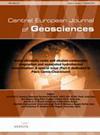Fluid inclusion and sulfur isotope thermometry of the Inkaya (Simav-Kütahya) Cu-Pb-Zn-(Ag) mineralization, NW TURKEY
引用次数: 7
Abstract
The Inkaya Cu-Pb-Zn-(Ag) mineralization, located about 20 km west of the Simav (Kütahya-Turkey), is situated in the northern part of the Menderes Massif Metamorphics. The mineralization is located along an E-W trending fault in the Cambrian Simav metamorphics consisting of quartz-muscovite schist, quartz-biotite schist, muscovite schist, biotite schist and the Arıkayası formation composed of marbles. Mineralized veins are 30–35 cm in width. The primary mineralization is represented by abundant galena, sphalerite, chalcopyrite, pyrite, fahlore and minor amounts of cerussite, anglesite, digenite, enargite, chalcocite, covellite, bornite, limonite, hematite and goethite with gangue quartz.Fluid inclusion studies on the quartz samples collected from the mineralized veins indicate that the temperature range of the fluids is 235°C to 340°C and the salinities are 0.7 to 4.49 wt. % NaCl equivalent. The wide range of homogenization temperatures indicates that two different fluid generations were trapped in quartz.Sulfur isotope studies of the sulfide minerals showed that all of the δ34S values are between −2.1 and 2.6 per mil. These values are a typical range for hydrothermal sulfide minerals that have sulfur derived from a magmatic source.Pyrite-galena and pyrite-chalcopyrite sulfur isotope fractionation is consistent with an approach to isotopic equilibrium, and calculated temperatures are 254.6 and 277.4°C for pyrite-galena and 274.7°C for pyrite-chalcopyrite. The microthermometric data and sulfur isotope thermometry indicate the existence of a hydrothermal fluid that circulated along the fault crossing the Simav metamorphics and Arıkayası formation.Fluid inclusion and sulfur isotope thermometry can be used in combination with ore petrographical and geological information to provide site-specific targets for meso-hypothermal metal concentrations.土耳其西北部Inkaya (simav - k tahya) Cu-Pb-Zn-(Ag)矿化流体包裹体及硫同位素测温
Inkaya铜铅锌银矿位于Simav (k tahya- turkey)以西约20公里处,位于Menderes地块变质岩的北部。矿床位于寒武系西马夫变质岩中一条东西向断裂,变质岩由石英-白云母片岩、石英-黑云母片岩、白云母片岩、黑云母片岩和大理岩组成的Arıkayası组组成。矿化脉宽30 ~ 35 cm。原生矿化以丰富的方铅矿、闪锌矿、黄铜矿、黄铁矿、辉钼矿和少量的铜铜矿、角长石、辉钼矿、辉铜矿、钴铜矿、斑铜矿、褐铁矿、赤铁矿、针铁矿和脉石石英为代表。对矿化矿脉石英样品的流体包裹体研究表明,流体温度范围为235℃~ 340℃,盐度为0.7 ~ 4.49 wt. % NaCl当量。均一温度的大范围表明石英中存在两代不同的流体。硫化物矿物的硫同位素研究表明,所有硫化物矿物的δ34S值均在−2.1 ~ 2.6 / mil之间,这是岩浆源硫的热液硫化物矿物的典型δ34S值范围。黄铁矿-方铅矿和黄铁矿-黄铜矿硫同位素分馏符合同位素平衡方法,黄铁矿-方铅矿计算温度分别为254.6℃和277.4℃,黄铁矿-黄铜矿计算温度分别为274.7℃。显微测温和硫同位素测温结果表明,该区存在沿断层循环的热液流体,该热液流体穿过西马夫变质岩和Arıkayası地层。流体包裹体和硫同位素测温可以结合矿石岩石学和地质信息,为中低温金属浓度提供特定地点的目标。
本文章由计算机程序翻译,如有差异,请以英文原文为准。
求助全文
约1分钟内获得全文
求助全文
来源期刊

Central European Journal of Geosciences
GEOSCIENCES, MULTIDISCIPLINARY-
自引率
0.00%
发文量
0
审稿时长
>12 weeks
 求助内容:
求助内容: 应助结果提醒方式:
应助结果提醒方式:


